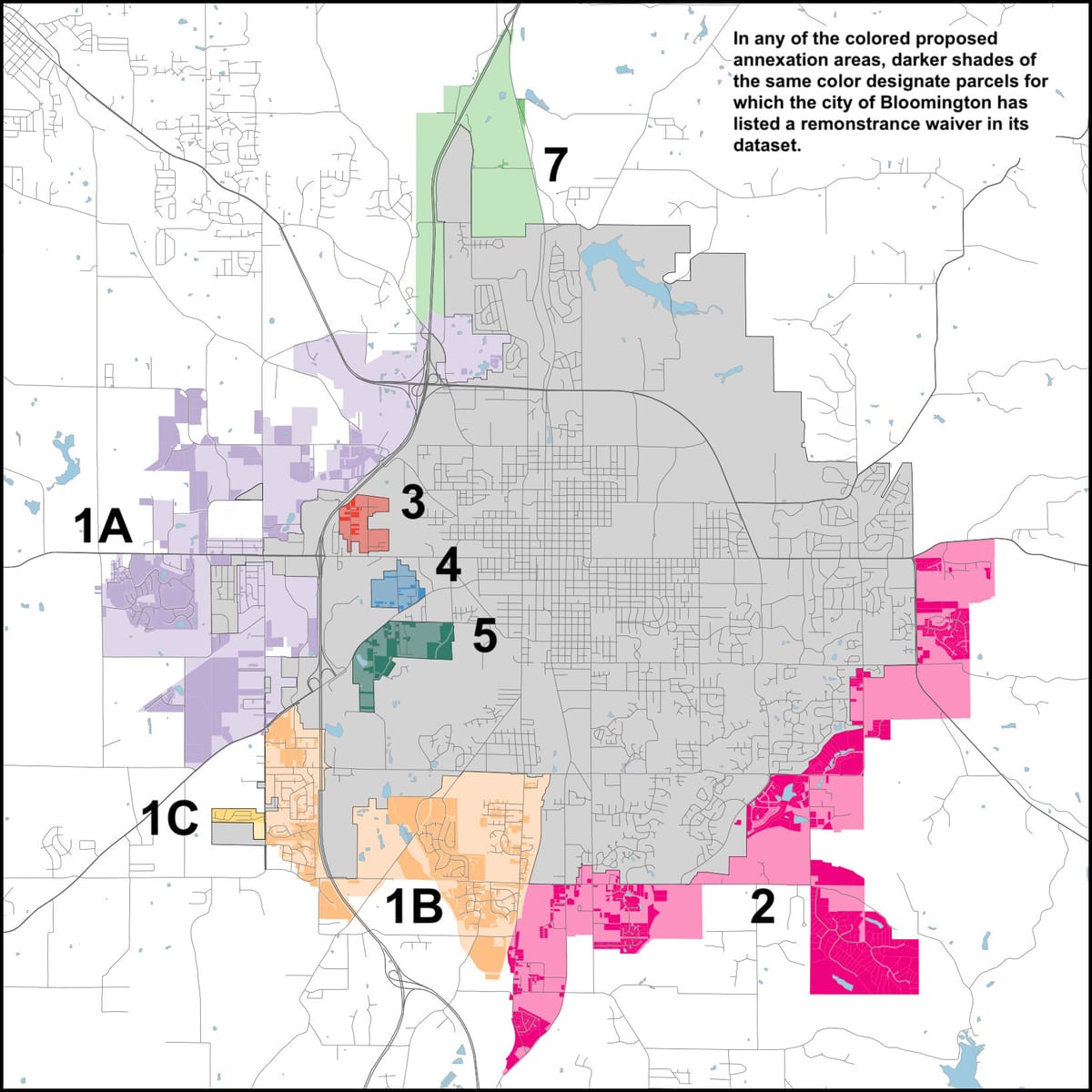Analysis | A first look at remonstrance waivers: Numerical impact of new law not yet measured for Bloomington’s annexation effort

July is the last full month of summer before Monroe County Community School classes start on Aug. 4.

The first day of school this year is also the date of a public hearing on Bloomington’s planned annexation of territory into the city.
The annexation of eight separate areas, each with its own parallel annexation process, would add more than 9,000 acres to Bloomington’s land area and about 14,000 new residents to its population.
With a public hearing on the horizon, and Bloomington city council votes expected in September, legal questions about remonstration waivers could come into sharper focus sooner than the time when the formal remonstration process would start.
Waivers are legal documents signed by a property owner giving up the right to remonstrate against annexation, in consideration of the ability to purchase utilities service from the city.
The key question is: Which waivers are valid? Indiana’s state legislature enacted a law in 2019 that voids any remonstration waiver signed before July 1, 2003. The city of Bloomington says it is proceeding as if the older waivers are valid.
A formal remonstration process would start only after the city council voted to enact the annexation ordinance for a particular area.
But the status of remonstration waivers is already important, because opponents of Bloomington’s annexation plans are working on “pre-petition” remonstrance efforts. The idea is to demonstrate that enough signatures to stop the annexation could surely be achieved. The hope is that the city council would be persuaded that passing an annexation ordinance for a given area would be fruitless.
Even though the “pre-petition” signature drives are informal and don’t have legally binding impact, their influence on Bloomington city council decision making could depend in part on the answer to the specific legal question of which waivers are valid and the numerical count of valid waivers in a given area.
If the property in question has a valid remonstration waiver attached, it is uncontroversial that a property owner’s signature doesn’t count towards the 65-percent threshold that would kill a city’s annexation ordinance.
But the city of Bloomington’s dataset of properties for annexation appears to list 4-digit waiver numbers for all properties with a waiver—without regard to when it was signed. The dataset does not include a field for the date of the waiver.
For example, a sample property waiver provided to the B Square by Monroe County’s recorder, with a handwritten number “1006” at the top, looks like it corresponds to the property in the city’s dataset with waiver number 1006. The waiver was signed in 1981.
That waiver would appear not to count under the 2019 statute that voids any remonstration waiver signed before July 1, 2003.
The persuasive punch of pre-petition signatures could depend in part on how many of them potentially involve properties with valid waivers. If Bloomington city councilmembers are confident that the city would prevail in a potential lawsuit challenging the 2019 law, they might look just at the number of waivers in the dataset for a given area, without regard to date.
Table: Number of Remonstration Waivers (any date) by Area
| Area | Waiver Count | Parcel Count | % w/ Waivers | % wo/ Waivers |
| 7 | 5 | 134 | 3.7% | 96.2% |
| 4 | 19 | 107 | 17.7% | 82.2% |
| 3 | 32 | 130 | 24.6% | 75.3% |
| 5 | 37 | 129 | 28.6% | 71.3% |
| 1-A | 782 | 1832 | 42.6% | 57.3% |
| 2 | 941 | 1781 | 52.8% | 47.1% |
| 1-B | 1307 | 2409 | 54.2% | 45.7% |
| 1-C | 102 | 107 | 95.3% | 4.6% |
| Total | 3225 | 6629 |
From the table of waiver counts, a couple of conclusions appear warranted. First, potential remonstrance petitions for Area 7 and Area 4 don’t look like they are susceptible to having very many signatures disqualified due to waivers, even if all the waivers in the dataset were found to be valid. Second, of the eight areas proposed for annexation it’s the three so-called “islands”—Area 3, Area 4, and Area 5—that are among the least susceptible to having signatures disqualified due to waivers.
Also a factor in the mix is that owners of tax exempt properties don’t count in the total for calculating the 65 percent of owners. And their signatures also don’t count towards those who have remonstrated.
Checking the dates of the waivers of all 3,225 parcels in the city’s dataset that have a waiver number would mean checking dates for just 958 waivers. That’s because several of the waivers are shared by more than one parcel.
The waiver with number “1599” is shared by 464 different properties. Four other waiver numbers are shared by more than 100 properties.
The B Square has made initial inquiries with the Monroe County recorder’s office and the city of Bloomington’s legal staff in the hope of developing an approach for matching waiver dates to the 4-digit waiver numbers in the city’s dataset.




Comments ()